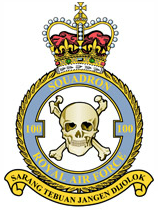No. 100 Squadron RAF
| No. 100 Squadron RAF | |
|---|---|

Official Squadron Badge of No. 100 Squadron RAF
|
|
| Active | 23 February 1917 – February 1942 15 December 1942 – 30 September 1968 1972 – present |
| Country |
|
| Branch |
|
| Role | Target facilities role, exercise and training support |
| Base | RAF Leeming |
| Motto(s) |
Malay: Sarang tebuan jangan dijolok ("Never stir up a hornet's nest") |
| Aircraft operated | BAE Systems Hawk T.1 |
| Battle honours | Western Front 1917–1918, Ypres 1917*, Somme 1918*, Independent Force and Germany 1918*, Malaya 1941–1942*, Fortress Europe 1943–1944*, Biscay Ports 1943–1945, Ruhr 1943–1945, Berlin 1943–1945*, German Ports 1943–1945, Baltic 1943-1945, France and Germany 1944–1945, Normandy 1944*, Walcheren Honours marked with an asterisk* are emblazoned on the Squadron Standard |
| Insignia | |
| Squadron Badge heraldry | "In front of two bones in saltire, a skull" |
| Squadron roundel |  |
No. 100 Squadron of the Royal Air Force is based at RAF Leeming in North Yorkshire, UK, and operates the British Aerospace Hawk T.1.
No. 100 was established on 23 February 1917 at Hingham in Norfolk as the Royal Flying Corps' first squadron formed specifically as a night bombing unit and comprised elements of the Home Defence Wing. The unit was mobilised and crossed from Portsmouth on 21 March 1917 to France and was first based at St Andre-aux-Bois, where it received twelve Royal Aircraft Factory F.E.2Bs aircraft on complement. These aircraft had been withdrawn from other units where they had operated in daylight, so modifications were required to adapt them for 100 Squadron's operational role.
On 1 April 1917, the unit moved to Izel-le-Hameau and took a further four aircraft on complement, in the form of BE2es. The squadron began operations on the night of 5/6 April 1917, when eleven FE2b aircraft attacked Douai airfield, where Manfred von Richthofen's 'Flying Circus' was based; Richthofen referred to this raid in his book, 'Der Rote Kampfflieger'. One hundred and twenty-eight 20 lb (9 kg) and four 40 lb (18 kg) bombs were dropped; four aircraft hangars were reported as having been set on fire and one of the attacking aircraft was lost. On 17 November 1918, 100 Squadron moved to RAF Saint Inglevert.
On 4 March 1918, the squadron was sent to Ochey, near Nancy, to form the nucleus of the Independent Air Force under Major General Hugh Trenchard. In August of that year, the unit converted to Handley Page 0/400 heavy bombers and therefore longer range sorties over industrial sites in Germany became possible. The squadron conducted these raids throughout the rest of the war; an aircraft from the unit was the last in war-time to return to base (on the night before the Armistice) from a raid.
...
Wikipedia
